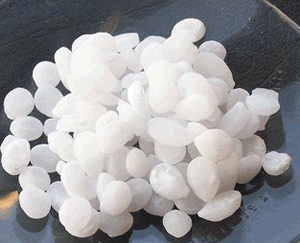A solution whose concentration is accurately known is called a standard solution.
Preparing a standard solution is not as easy as dissolving an accurate mass of solute in water to give a known volume of solution. Why? Because many substances are impure. Some will react with gases and water from the atmosphere or simply decompose over time.
Preparing a solution of sodium hydroxide with an accurately known concentration is very difficult. Sodium hydroxide absorbs water from the atmosphere and reacts with carbon dioxide according to the reaction below.
CO2(g) + 2 NaOH(aq) → Na2CO3(aq) + H2O(l)
If pellets of NaOH are left out of their container they quickly start to abosrb water from the atmosphere as shown the right. Therefore weighing this sample of NaoH will not give us an accurate mass of NaOH as some of the weight recorded by the electronic balance is due to water and other impurities.
Click to see a relatively dry sample of NaOH
Click to see the same sample after 10 minutes. Click to see a time lapse.

1) Easily obtained in pure form.
2) It should have a known formula.
3) It must be stored without decomposing or reacting with atmospheric gases.
4) Have a high molar mass to minimise errors in weighing.
When titrating an acid a suitable primary standard is a base such as anhydrous sodium carbonate Na2CO3 (105.99 g/mol)
For the titration of bases suitable primary standards are potassium hydrogen phthalate (KHP): KHC8H4O4, mol wt. = 204.23 g/mol, potassium hydrogen iodate: KH(IO3)2, mol wt. = 389.92 g/mol
For redox titrations potassium dichromate is used: K2Cr2O7, mol wt. = 294.19 g/mol
A standard solution can be prepared by using a primary standard and an accurately known volume of water using a volumteric flask. View the video on the right